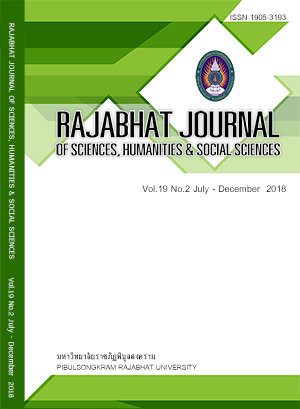LEARNING ABILITIES AND ACTIVITIES BASED ON MULTIPLE INTELLIGENCES OF FIRST YEAR STUDENTS, INTERNATIONAL COLLEGE, SUAN SUNANDHA RAJABHAT UNIVERSITY
Keywords:
multiple Intelligences, learning abilities, learning activities, teaching strategiesAbstract
The purpose of this study aimed to investigate learning abilities and to analyze activities based on multiple intelligences of first year students, International College, Suan Sunandha Rajabhat University. The samples were 240 first year students of Airline Business Program, International College, Suan Sunandha Rajabhat University. The research instruments were Armstrong’s questionnaire on learning abilities based on multiple intelligences, and academic documents and research on learning activities based on Multiple Intelligences, which included questionnaires and activities to promote and develop the students’ learning abilities based on the multiple intelligences and the data were analyzed using frequency, percentage, mean and standard deviation. The results showed students who applied multiple intelligences, had learning abilities on intrapersonal intelligence at the highest level and followed by linguistic intelligence, musical intelligence, naturalist intelligence, interpersonal intelligence, bodily-kinesthetic intelligence, spatial intelligence, and logical-mathematical intelligence, respectively. Appropriate teaching and learning strategies for each type of multiple intelligences could be divided into two categories, which were capitalizing and developing students’ multiple intelligences. For capitalizing students’ multiple intelligences: intrapersonal intelligence, linguistic intelligence, musical intelligence, and naturalist intelligence, teaching strategies should be emphasized on self-learning, communicating, integrating music and nature concepts in lessons. For developing students’ multiple intelligences: interpersonal intelligence, bodily-kinesthetic intelligence, spatial intelligence, and logical-mathematical intelligence, the strategies used in classroom should emphasize team working, acting and moving, applying visual patterns and techniques, and calculating, grouping and reasoning.
References
Armstrong T. Multiple Intelligences in the Classroom. 3rd ed. Alexandria, VA: Association for Supervision and Curriculum Development, 2009.
Dachakupt P. 5C Skills for Developing Learning Units and Integrated Learning Manageme. Bangkok: Chulalongkorn University Press, 2007.
Dachakupt P, Yindeesuk P. Learning Management in the 21st Century. Bangkok: Chulalogkorn University Press, 2015.
Fry H. A Handbook for Teaching & Learning in Higher Education. London: Routledge, 2007.
Gardner H. Frames of Mind: The Theory of Multiple Intelligences. NY: Basic, 1983.
Gardner H. Multiple Intelligences New Horizons. United States of America: Basic Books, 2006.
Laddaklom S. The Study of Early Childhood’s Multiple Intelligence Abilities Obtained through Field Trip Study by Using the Multiple Intelligences Learning. Master of Education (Early Childhood Education), Graduate School, Srinakharinwirot University, 2008.
Light G, Cox R. Learning and Higher Education: The Reflective Professional. London: Sage, 2001.
Nolen JL. Multiple Intelligences in the Classroom. Education, 124, 131-142, 2003.
Raijaroen J. Effects of Using Multiple Intelligence Theory Activity in Mathematics Learning on Mathematical Connection Ability and Creative Thinking of Mathayomsuksa III Students. Master of Education (Secondary Education), Graduate School, Srinakharinwirot University, 2009.
Sanhachawee A. Multiple Intelligence in the Classroom, 2014. Bangkok: Department of Curriculum and Instruction Development, Ministry of Education. Available at: https://www.institute4learning.com/multipleintelligences.php. Accessed April 11, 2016.
Temnong C. The Result of an Management Plan to Support the Course according to the Theory of Multiple Intelligences that Enphasize on Vision and Spatial Intelligences to Increase of Elementary Student Prathomsuksa 3, Wt Huay Phai School, Ratchaburi Province. Master of Education (Research Teachnology and Curriculum Development), Graduate School, Rajamangala University of Technology Thanyaburi, 2014.
Downloads
Published
How to Cite
Issue
Section
License
Each article is copyrighted © by its author(s) and is published under license from the author(s).










